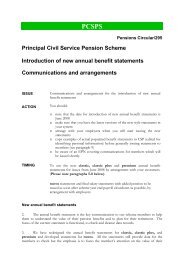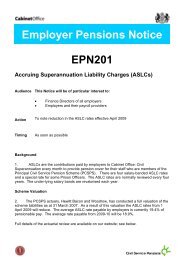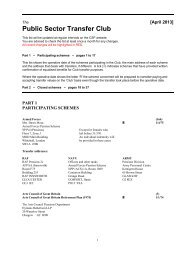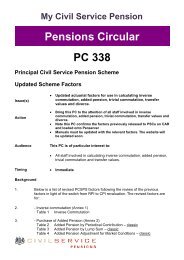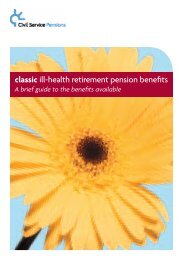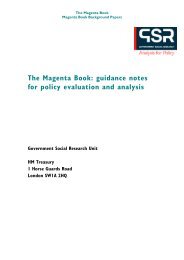Partnership Pension Account - The Civil Service
Partnership Pension Account - The Civil Service
Partnership Pension Account - The Civil Service
You also want an ePaper? Increase the reach of your titles
YUMPU automatically turns print PDFs into web optimized ePapers that Google loves.
www.civilservice-pensions.gov.uk<br />
This booklet is published by <strong>Civil</strong> <strong>Service</strong> <strong>Pension</strong>s.<br />
© Crown Copyright June 2008<br />
Printed by St Ives Direct PPA-1
partnership pension account
Contents<br />
partnership pension account 3<br />
Paying into your pension 4<br />
Choosing your pension fund 8<br />
How to open a partnership pension account 13<br />
Leaving the <strong>Civil</strong> <strong>Service</strong> 14<br />
Making changes to your partnership pension 16<br />
Finding out more 17<br />
Technical terms 18<br />
Annex A – Contribution tables 20<br />
Note: Text in bold in this booklet is explained in the Technical<br />
terms section on page 18.<br />
This booklet does not cover every aspect. <strong>The</strong> full details are<br />
contained only in the rules, which are the legal basis of the scheme.<br />
You should note that nothing in this booklet can override the rules,<br />
and in the event of any difference, the rules will apply.<br />
2
partnership pension account<br />
What is a partnership<br />
pension account?<br />
partnership is a stakeholder pension<br />
with employer contributions. This<br />
is a type of personal pension. You<br />
do not have to make any payments<br />
to have a partnership pension<br />
account as your employer will make<br />
contributions anyway. If you do<br />
choose to contribute, your employer<br />
will match your payments up to a<br />
further 3% of your pensionable salary.<br />
How does it work?<br />
<strong>The</strong>se contributions are invested for<br />
you by your chosen provider. Over the<br />
years, your pension fund should grow<br />
with investment returns (the money<br />
earned by your investments), and<br />
you use the resulting ‘pot’ to either<br />
buy a pension when you retire or to<br />
leave to someone on your death.<br />
3
4<br />
Paying into your pension<br />
Why open a partnership<br />
pension account?<br />
It needn’t cost you anything!<br />
Your employer will pay a monthly<br />
contribution into your partnership<br />
pension account depending on your<br />
age and salary. If you do wish to<br />
pay something, your employer will<br />
match any regular contributions<br />
you make (up to 3% of your salary)<br />
and your fund will grow faster<br />
giving you a bigger ‘pot’ to buy<br />
your pension when you choose.<br />
You will also be able to take up to 25%<br />
of this ‘pot’ as a tax-free lump sum<br />
(subject to the Lifetime Allowance).<br />
You can take this at any time from<br />
age 50 to 75 (age 55 to 75 from<br />
2010) even if you are still working.<br />
If you leave the <strong>Civil</strong> <strong>Service</strong> you<br />
can take this pension with you, it is<br />
yours for life. In addition, opening<br />
a partnership pension account<br />
also gives you access to other <strong>Civil</strong><br />
<strong>Service</strong> benefits. If you are unable<br />
to work through ill health, a lump<br />
sum may be payable, or if you were<br />
to die in service, a lump sum would<br />
be payable to your dependants.<br />
By not joining partnership you<br />
will miss out on these benefits.<br />
<strong>The</strong> Cabinet Offi ce has chosen three<br />
partnership pension providers to give<br />
you plenty of choice in how to invest<br />
your money: Standard Life, Scottish<br />
Widows and TUC (Prudential).<br />
How much should I pay?<br />
You do not have to contribute anything.<br />
<strong>The</strong> partnership pension account<br />
offers you the opportunity of having a<br />
‘free’ pension. Your employer will pay<br />
your age-related contribution anyway<br />
(see Table 1 on page 5). But if you do,<br />
your employer will pay an additional<br />
amount to match your contributions up<br />
to 3% of your pensionable earnings.<br />
So if you decide to contribute 2% of<br />
your pensionable earnings, your<br />
employer will pay an extra 2% on top<br />
of the age-related contribution. If you<br />
decided to contribute 5%, your employer<br />
would pay an extra 3%, as the extra<br />
matching contributions are limited to 3%.<br />
Your contributions will be based on your<br />
pensionable earnings so if you are<br />
receiving reduced pay, you will only pay<br />
contributions on the pay you actually<br />
receive.<br />
See Annex A on page 20 for ready<br />
reckoners that show what different<br />
contribution rates mean, in terms of both<br />
the cost to you in take-home pay each<br />
month and also of the total amount<br />
that will go into your pension ‘pot’.<br />
What will my employer pay?<br />
Your employer will make a contribution<br />
as a percentage of your pensionable<br />
earnings. This varies according to<br />
your age as at the beginning of the<br />
tax year (that is, as at the last<br />
6 April) and so it may increase in<br />
the future. Current contribution rates<br />
are shown in Table 1 on page 5.
Table 1: Employer contributions<br />
Age at the<br />
last 6 April<br />
Percentage of<br />
your pensionable<br />
earnings<br />
Under 21 3<br />
21 to 25 4.5<br />
26 to 30 6.5<br />
31 to 35 8<br />
36 to 40 10<br />
41 to 45 11.5<br />
46 or over 12.5<br />
Your employer will make these<br />
contributions even if you decide not<br />
to pay anything into your account.<br />
See the table in Annex A ‘Employer<br />
contribution if you pay nothing’ to<br />
check how much money could be<br />
going into your account each month.<br />
You can always decide to pay money<br />
in at a later stage. If you do, your<br />
employer will then match the level<br />
of your contributions, up to 3% of<br />
your pensionable earnings.<br />
What earnings are pensionable?<br />
As a general rule, only permanent<br />
items of pay are pensionable.<br />
This will include any allowances<br />
which your employer tells you are<br />
pensionable, but will not include<br />
payments such as overtime.<br />
Bonus payments do not normally<br />
count as pensionable earnings, but<br />
if you receive pensionable bonus<br />
payments, your employer (and you,<br />
if you choose to contribute) will pay<br />
contributions on them. You may also<br />
have some non-cash pensionable<br />
earnings. For example, some<br />
people may receive a 2% uniform<br />
allowance, and others may have an<br />
allowance for accommodation. In<br />
these circumstances, your employer<br />
(and you, if you choose to contribute)<br />
will also pay contributions based on<br />
the equivalent cash value of these<br />
non-cash pensionable earnings.<br />
If you are on reduced pay during<br />
maternity leave, and in certain<br />
other circumstances, your employer<br />
will make contributions to your<br />
partnership pension account<br />
based on the pay that you would<br />
have expected to have had if<br />
you had still been working.<br />
5
How much am I allowed to pay?<br />
<strong>The</strong>re is no limit on the amount that<br />
you can pay into your partnership<br />
pension account. You will receive tax<br />
relief on any contributions you make<br />
up to 100% of your taxable earnings<br />
or £3,600, whichever is the higher<br />
(subject to the Annual Allowance).<br />
Your employer can only pay<br />
contributions on earnings up to a<br />
limit set by Cabinet Offi ce. This limit<br />
is called the ‘earnings cap’. Your<br />
contributions are not restricted.<br />
Do I get tax relief?<br />
Your employer’s contributions are<br />
based on your pay before tax (your<br />
gross pay). But your own contributions<br />
are taken from you after you have paid<br />
tax. You pay a reduced contribution<br />
which takes account of the tax relief<br />
which the pension provider will claim<br />
back on your behalf. So, for example,<br />
if you wanted to pay £100, we would<br />
take £80 from your net pay (£100<br />
less £20 basic-rate income tax). <strong>The</strong><br />
pension provider would then claim<br />
back £20 from the HMRC, so the<br />
total amount going into your pension<br />
fund based on your contributions<br />
would be £80 + £20 = £100.<br />
If you are a higher-rate taxpayer,<br />
you should claim the extra tax<br />
relief on your yearly tax return.<br />
If you are a lower-rate taxpayer, you<br />
effectively get credited with more tax<br />
than you have paid, so you win!<br />
Example<br />
Sue has pensionable earnings<br />
of £1,500 (gross) in the month.<br />
Sue was 28 at the beginning of the<br />
current tax year and has chosen<br />
to pay contributions of 2%.<br />
Sue’s contribution is taken from<br />
her pay after basic-rate income<br />
tax at 20% has been taken off.<br />
2% x £1,500 x (100-20) ÷ 100 = £24<br />
Sue’s employer contributes:<br />
• an age-related contribution of<br />
6.5% x £1,500 = £97.50; and<br />
• a matching contribution of<br />
2% x £1,500 = £30.<br />
Total employer contribution =<br />
£97.50 + £30 = £127.50<br />
Sue’s pension provider claims back<br />
the tax on Sue’s contribution.<br />
Tax claimed back = £24 x<br />
20 ÷ (100-20) = £6<br />
Total payment into Sue’s pension<br />
fund = £24 + £127.50 + £6 = £157.50<br />
6
How do I make my payments?<br />
Your employer will take regular<br />
(normally monthly) contributions from<br />
your pay and pay it automatically<br />
to your chosen provider.<br />
What happens if I’m not working?<br />
If you are not receiving earnings<br />
from us (for example, if you are on<br />
a career break), you may continue<br />
to make contributions up to £3,600<br />
a year. Your employer will not<br />
normally be contributing, so the<br />
best way to make contributions is<br />
probably to set up a direct debit<br />
to your partnership pension<br />
account from your bank account.<br />
What about National Insurance?<br />
You pay National Insurance (NI)<br />
contributions at the standard rate.<br />
<strong>The</strong>se contributions will entitle you to<br />
the basic State Retirement <strong>Pension</strong><br />
and State Second <strong>Pension</strong> (S2P)<br />
(the new name for the State Earnings-<br />
Related <strong>Pension</strong>s (SERPS)). <strong>The</strong><br />
current rates are available on the HMRC<br />
website: www.hmrc.gov.uk/rates<br />
Alternatively, ask your employer.<br />
7
Choosing your pension fund<br />
8<br />
What choice do I have?<br />
You need to choose with which<br />
stakeholder pension provider<br />
you want to invest your, and your<br />
employer’s, contributions.<br />
Stakeholder pensions are a type<br />
of personal pension which offer<br />
reduced charges and make it easier<br />
for you to move your pension from<br />
job to job. We have chosen a panel<br />
of stakeholder pension providers to<br />
offer the partnership pension account<br />
based on their financial strength,<br />
their funds, their charges, their<br />
administration and their willingness to<br />
work with us to provide the pension<br />
account. <strong>The</strong> providers are as follows.<br />
• Scottish Widows<br />
• Standard Life<br />
• TUC/Prudential<br />
Your Starter Pack contains more<br />
information about each of the<br />
providers including details of how<br />
to contact them for more details.<br />
Where do I start?<br />
Read the leaflets about the providers<br />
and decide which of them you want to<br />
contact for more information. You can<br />
contact as many of the providers as you<br />
like. <strong>The</strong>y will send you a full information<br />
pack within a few days. Or, you might<br />
want to do some research on the<br />
Internet. You can either go direct to the<br />
providers’ websites (details in leaflets)<br />
or use the links from our website at<br />
www.civilservice-pensions.gov.uk<br />
<strong>The</strong> things you might want to<br />
think about when choosing your<br />
pension provider might include:<br />
• the sort of organisation offering<br />
the stakeholder pension;<br />
• the types of funds on offer;<br />
• the funds’ performance; and<br />
• the level of charges.<br />
You must choose just one provider,<br />
but remember that you don’t have to<br />
invest all your money in a single fund.<br />
<strong>The</strong> providers’ application forms<br />
allow you to split your contributions<br />
across a range of funds if you want.<br />
Do I have to choose an<br />
investment fund?<br />
You will see from the providers’<br />
information that each provider<br />
offers a wide range of investment<br />
funds, including a ‘default’ option.<br />
If you choose a provider but don’t<br />
want to choose an investment<br />
fund, all contributions made by you<br />
or your employer will be invested<br />
in the provider’s default fund.<br />
Read the providers’ information to find<br />
out about the different funds on offer.<br />
When looking at past performance,<br />
remember that it may not be a reliable<br />
guide to performance in the future.<br />
How do I choose a fund?<br />
A successful investment is not simply<br />
one that delivers high returns (the<br />
money your investments earn).
It is also one that gives you the<br />
right balance of investment return<br />
and security for your money.<br />
What is the ‘right’ balance will<br />
vary from one person to another<br />
and will also vary with age.<br />
You must remember that the value of<br />
some investments can go down as<br />
well as up, and this is often shown<br />
in the returns available to investors.<br />
Put simply, if you are guaranteed<br />
that the amount you have invested<br />
can never go down, you cannot<br />
expect to get very high returns.<br />
On the other hand, if you are prepared<br />
to take the risk that your investment<br />
might go up and down in value, you<br />
would expect the possibility of higher<br />
returns as the price to pay for that risk.<br />
As a general rule, if you have many<br />
years before you retire, you may<br />
wish to consider having at least part<br />
of your pension fund invested in<br />
investments which are ‘riskier’, but<br />
as you approach retirement, you may<br />
wish to move into investments which<br />
are guaranteed. This makes sure that<br />
your pension ‘pot’ will not fall in value<br />
just before you retire, when you<br />
want to use it to buy yourself an<br />
‘annuity’ (the income you buy with<br />
your pension). Every situation is<br />
different and what is right for someone<br />
else may not be right for you.<br />
<strong>The</strong> most appropriate funds for you<br />
will be those which most closely match<br />
your attitude to risk and investment.<br />
Your attitude to investment might<br />
also include things like the type of<br />
industries you are happy to invest in.<br />
For example, you might prefer to have<br />
your pension in an ‘ethical’ fund which<br />
does not invest in certain companies<br />
or sectors of industry. We suggest that<br />
you read the providers’ information<br />
packs and, if you need to, talk through<br />
with the providers the differences<br />
between the funds they offer.<br />
You may wish to consult an<br />
independent financial adviser.<br />
You are likely to have to pay for<br />
their advice, but if you belong to a<br />
union, you may want to ask them<br />
if they have access to independent<br />
financial advice at special rates.<br />
What are ‘lifestyle’ funds?<br />
Many providers offer a ‘lifestyle’<br />
option for people who don’t want to<br />
have to choose a fund. <strong>The</strong> basic idea<br />
is that your money is invested mainly<br />
in company shares (or ‘equities’)<br />
while you are young and then<br />
switched into safer investments as<br />
you approach retirement. You could,<br />
of course, manage your investments<br />
for yourself along these lines, but<br />
the ‘lifestyle’ option means that the<br />
switching happens automatically.<br />
9
If you think that a ‘lifestyle’ option<br />
sounds like a good idea for you,<br />
remember that the details will vary<br />
from one provider to another. In<br />
particular, you need to be happy that<br />
you like the sound of the fund (or<br />
funds) used for investing when you<br />
are young and that the system for<br />
switching you into safer investments<br />
looks appropriate for you.<br />
If you choose a ‘lifestyle’ option, it<br />
is very important that your pension<br />
provider knows when you plan to draw<br />
your pension, as this affects when<br />
they start switching you into safer<br />
investments. You should make sure<br />
you tell your provider in good time<br />
when you plan to draw your pension.<br />
How will I find out how my fund<br />
is performing?<br />
Your provider will send you a<br />
statement each year. This will show<br />
the value of your fund and the<br />
contributions paid, together with a<br />
rough idea of what this may mean in<br />
pension terms at pension age. You<br />
must, therefore, tell your provider<br />
whenever you change your address.<br />
You can also view the performance<br />
of each of the funds on the<br />
providers’ websites. We will also<br />
constantly review the investment and<br />
administrative performance of all the<br />
providers, and will report on this to<br />
unions and to employers every year.<br />
You can track the performance<br />
of your fund at any time by<br />
registering with your provider, to<br />
use their secure online facilities.<br />
Will the Government guarantee<br />
my pension?<br />
<strong>The</strong> Government cannot<br />
guarantee your pension.<br />
10
How big will my pension be?<br />
<strong>The</strong> amount of your pension will<br />
depend on:<br />
• the amount of money invested in<br />
your fund;<br />
• the performance of your<br />
investment fund;<br />
• when you decide to take your<br />
pension – that is, how long the<br />
money remains invested;<br />
• what type of annuity you choose;<br />
• the cost of annuities at the time you<br />
choose to retire. (<strong>The</strong> cost of an<br />
annuity is subject to market forces.)<br />
It is important that you give your<br />
pension fund a regular ‘health<br />
check’ over the years to make sure<br />
you are on track to get the sort of<br />
retirement income you want. You<br />
will receive annual statements that<br />
show the value of your fund, to help<br />
you with this. And remember that<br />
contributions made while you are<br />
young are going to have more years<br />
to grow with investment returns.<br />
When can I draw my pension?<br />
Under current legislation, you can<br />
draw your partnership pension at<br />
any time between the ages of 50<br />
and 75 (age 55 to 75 from 2010).<br />
You don’t have to retire to take your<br />
pension. You choose the timing to fit<br />
in with your personal circumstances.<br />
You also decide whether or not<br />
you want to provide a pension after<br />
your death for your dependants.<br />
When you draw your pension, you<br />
can choose to take up to 25% of your<br />
pension ‘pot’ as a tax-free lump sum<br />
(subject to the Lifetime allowance).<br />
How do I get my pension?<br />
You will need to contact your<br />
provider to start the process.<br />
You will need to turn your pension ‘pot’<br />
into an income for life – a pension.<br />
This is also known as an annuity.<br />
Insurance companies sell annuities,<br />
but you do not have to buy your<br />
annuity from the pension provider<br />
you have used over the years. Your<br />
provider will give you an illustration of<br />
the amount of annuity your pension<br />
‘pot’ would buy with them, but you<br />
can buy your annuity with a pension<br />
provider outside the <strong>Civil</strong> <strong>Service</strong><br />
partnership arrangements. This is<br />
called an ‘open market option.’ This<br />
means that you can shop around<br />
for the best deal. You may wish to<br />
consult an Independent Financial<br />
Adviser to help you with this.<br />
When you come to buy your annuity,<br />
you will have a lot of flexibility in<br />
the sort of pension you can take.<br />
11
12<br />
Things to think about will<br />
include the following:<br />
Tax-free cash<br />
You can usually take up to 25% of<br />
your pension ‘pot’ as a tax-free lump<br />
sum when you retire. But obviously,<br />
as this reduces the sum you have<br />
available to buy an annuity with,<br />
your pension income will be smaller.<br />
Who do you want a pension for?<br />
You may choose to buy an income<br />
for just yourself, or you may want<br />
your spouse, civil partner or partner<br />
to continue to get an income after<br />
you die. If you want to provide<br />
an ongoing income for your<br />
dependants, what percentage of<br />
your own income should this be?<br />
<strong>Pension</strong> increases in retirement<br />
You will need to choose the way<br />
in which your income will increase<br />
from year to year. If you choose your<br />
pension to be a fixed amount of money,<br />
it will reduce in value as inflation goes<br />
up each year. However, if you choose<br />
a pension that goes up with inflation<br />
each year, you will find that the pension<br />
is quite a bit less to start with than the<br />
pension you would get if you choose a<br />
pension of a fixed amount each year.<br />
<strong>The</strong>se are only some of the things<br />
you should think about when nearing<br />
retirement. If your pension ‘pot’ is<br />
very large, you may be interested<br />
in ‘income draw down’, where you<br />
can draw income from your fund<br />
and delay buying an annuity.<br />
Turning your pension ‘pot’ into<br />
income is an important decision<br />
and one where you might want to<br />
get independent financial advice,<br />
particularly if your pension ‘pot’ is<br />
the whole of your pension savings.<br />
Can I carry on working after I draw<br />
my pension?<br />
Yes. Drawing your pension doesn’t have<br />
to be linked to retiring from work. You<br />
can even open another partnership<br />
pension account with the same or<br />
different partnership pension provider.<br />
What about State benefits?<br />
You will receive a basic State<br />
Retirement <strong>Pension</strong> linked to the<br />
number of years when you have paid<br />
National Insurance contributions.<br />
On top of this, you will receive the<br />
State Second <strong>Pension</strong> (S2P). If you<br />
want to, you can choose to opt out of<br />
(leave) S2P. If you do opt out, although<br />
you and your employer continue<br />
to pay the higher rate of National<br />
Insurance contributions, the State will<br />
pay an age-related rebate (refund)<br />
into a separate pension ‘pot’ for you.<br />
This is called ‘contracting-out’.<br />
Ask one of the pension providers<br />
for more details if you think you<br />
might be interested in this. Make<br />
sure you understand what you are<br />
giving up and what you might receive<br />
in the future before you decide.
How to open a partnership pension account<br />
If you are:<br />
A new entrant<br />
Switching from either<br />
premium to partnership<br />
or nuvos to partnership<br />
Opting in to<br />
partnership (having<br />
previously opted out)<br />
Please follow<br />
the guidance in<br />
your <strong>Pension</strong><br />
Choices booklet<br />
contained in<br />
your Starter<br />
Pack<br />
Contact the partnership<br />
pension providers for<br />
information on their particular<br />
schemes and for an<br />
application pack. Or, if you<br />
wish, download an application<br />
pack from the provider’s<br />
website. You can contact<br />
more than one provider to<br />
help you to make your choice.<br />
(For provider details, see the<br />
section ’Finding out more’)<br />
Contact your pensions<br />
administrator. <strong>The</strong><br />
administrator has to<br />
check your eligibility<br />
to opt back in to<br />
partnership. If you are<br />
eligible to opt in, they<br />
will give you further<br />
instructions on the<br />
rejoining process<br />
Contact your employer for a<br />
‘switch’ form. Alternatively,<br />
download it from our website:<br />
www.civilservice-pensions.gov.uk<br />
‘Publications, forms and rules’<br />
Complete both the application<br />
and switch forms and return<br />
them to your employer<br />
Your employer will then:<br />
• set up the employer contributions<br />
and arrange for any deductions<br />
from your salary, if applicable.<br />
• complete the employer section<br />
on the application form and send<br />
it to your chosen provider.<br />
You will then receive confirmation<br />
from your provider that your<br />
account has been set up.<br />
13
Leaving the <strong>Civil</strong> <strong>Service</strong><br />
What happens if I leave my job?<br />
If you resign, your employer’s<br />
contributions will stop.<br />
Your pension fund is yours, no matter<br />
what your job.<br />
Depending on the pension<br />
arrangements in your new job, you<br />
may be able to carry on paying into<br />
your pension account or you may just<br />
leave it to earn investment returns. Or,<br />
you may want to transfer your fund to<br />
another pension provider or to your<br />
new employer’s pension scheme.<br />
<strong>The</strong> choice is yours but, if you<br />
are considering transferring your<br />
fund to another provider or to a<br />
new employer’s pension scheme,<br />
make sure you understand what<br />
you are giving up and what<br />
you are getting in return.<br />
What happens if I am<br />
made redundant?<br />
Your employer will pay you<br />
compensation for loss of employment.<br />
Your employer’s contributions into<br />
your pension account will stop<br />
when you leave work, but your fund<br />
will continue to earn investment<br />
returns. You may, if you wish, make<br />
arrangements with your provider to<br />
continue to pay into your pension fund.<br />
Alternatively, you may transfer your<br />
fund to another pension provider.<br />
If you take up work in the future, you<br />
may be able to transfer your fund to<br />
your new employer’s pension scheme<br />
if you wish. This will, however, depend<br />
on the particular arrangements<br />
of your employer’s scheme.<br />
<strong>The</strong> choice is yours but, if you<br />
are considering transferring your<br />
fund, make sure you understand<br />
what you are giving up and what<br />
you are getting in return.<br />
14
What happens if I become too ill<br />
to work?<br />
If you have to leave the <strong>Civil</strong> <strong>Service</strong><br />
before you are 60, and our medical<br />
adviser agrees that you cannot do<br />
your job because your health has<br />
broken down permanently, we may<br />
pay you a lump sum when you leave.<br />
We will work this out as 20% of your<br />
pensionable pay for every year of<br />
service, up to a limit of three years’<br />
pay. We will only pay the lump sum<br />
if you have worked for us for at least<br />
two years, and it cannot be more than<br />
the pay you would have had if you had<br />
continued in work until you were 60.<br />
If you leave the <strong>Civil</strong> <strong>Service</strong> because<br />
of ill-health, you may want to consider<br />
drawing your pension early. This is<br />
usually possible, but your pension is<br />
likely to be reduced because of early<br />
payment. If you are so ill that you<br />
are expected to have a shorter life<br />
expectancy, your pension provider<br />
will take this into account when they<br />
work out the amount of your pension.<br />
What happens if I die before<br />
I retire?<br />
If you die before you draw your<br />
pension, your pension provider<br />
will pay the value of your pension<br />
‘pot’ to the person you have<br />
named on the pension application<br />
form and/or provider’s form.<br />
<strong>The</strong> value of your pension ‘pot’ will<br />
be the contributions that you and<br />
your employer have made, plus<br />
investment returns over the years.<br />
If you die before you leave the <strong>Civil</strong><br />
<strong>Service</strong>, we will also pay a lump sum<br />
of three times your pensionable<br />
earnings to the person you have<br />
named, either on your <strong>Pension</strong>Choices<br />
form, or on a later amendment. If you<br />
want to change your nomination at any<br />
time, you can do this using the Death<br />
Benefit Nomination form available on<br />
the <strong>Civil</strong> <strong>Service</strong> <strong>Pension</strong>s website<br />
www.civilservice-pensions.gov.uk<br />
under ‘Publications, Rules and Forms’.<br />
Alternatively, you should contact your<br />
employer’s pensions administrator.<br />
15
Making changes to your partnership pension<br />
Can I change to another<br />
investment fund?<br />
You can change investment funds<br />
whenever you want to – just contact<br />
your provider.<br />
Can I change my contributions?<br />
You can change the level of your<br />
monthly contributions when you like,<br />
but you should give your employer<br />
three months’ notice in writing.<br />
You can make extra contributions<br />
whenever you like during the year,<br />
but your employer will not pay<br />
matching contributions. <strong>The</strong> best<br />
way of making extra contributions is<br />
to send a cheque to your provider.<br />
Can I change to a different<br />
pension provider?<br />
If you want to change to a different<br />
pension provider on our panel,<br />
you can only do this from 1 April<br />
or 1 October in any year. You<br />
need to give your employer at<br />
least three months’ notice.<br />
Can I move to the premium or<br />
nuvos pension scheme?<br />
Depending on the pension choices<br />
you were given when you started<br />
work, you can either ‘switch’ to<br />
premium or nuvos. You will not have<br />
the choice of both schemes. If you do<br />
decide to switch, you will have one<br />
further opportunity to switch back to<br />
partnership if you wish to do so.<br />
We only allow you to switch either<br />
on 1 April or 1 October each year,<br />
and you must give your employer at<br />
least three months’ notice in writing.<br />
To find out which scheme applies to<br />
you, contact your employer. To find out<br />
more about switching, contact your<br />
employer’s pensions administrator.<br />
16
Finding out more<br />
Who do I go to for help?<br />
For questions about investment<br />
choices and your pension fund,<br />
contact your pension provider.<br />
Provider contact details:<br />
Scottish Widows<br />
Scottish Widows Direct Sales<br />
PO Box 17037,<br />
69 Morrison Street,<br />
Edinburgh EH3 8WZ<br />
Telephone helpline: 0800 838 312<br />
email: cs.stakeholder@scottishwidows.co.uk<br />
Standard Life<br />
<strong>Civil</strong> <strong>Service</strong> Team<br />
Group <strong>Pension</strong>s (J1),<br />
Standard Life House,<br />
30 Lothian Road,<br />
Edinburgh EH1 2DH<br />
Telephone helpline: 0800 33 33 09<br />
email: publicsector_service@standardlife.com<br />
TUC Prudential<br />
Stakeholder <strong>Service</strong> Centre<br />
Prudential,<br />
Craigforth,<br />
Stirling FK9 4UE<br />
Telephone helpline: 0845 070 6666<br />
email: civilservice@prudential-pensions.co.uk<br />
To find out more about<br />
‘contracting-out’ of (leaving)<br />
the State Second <strong>Pension</strong>, ask<br />
any of the pension providers.<br />
To find out more about ill-health or<br />
death benefits, ask your employer<br />
or their pensions administrator.<br />
17
Technical terms<br />
Annual Allowance<br />
<strong>The</strong> Annual Allowance is the<br />
amount by which the value of your<br />
pension savings can go up in any<br />
year before you pay tax at the higher<br />
rate. This amount is set by HMRC.<br />
Annuity<br />
A pension for life. When you want<br />
to draw your pension, you will<br />
use your pension ‘pot’ to buy an<br />
annuity which will provide your<br />
income during retirement.<br />
Contracting-out<br />
You can opt out or ‘contract-out’ of<br />
(leave) the State Second <strong>Pension</strong>.<br />
Although you and your employer<br />
continue to pay the higher rate of<br />
National Insurance contributions,<br />
the State will pay an age-related<br />
rebate (refund) into a separate<br />
pension ‘pot’ for you.<br />
Earnings cap<br />
This is the limit on earnings on which<br />
you can contribute to your pension.<br />
Income draw down<br />
This is an option to draw income<br />
from your fund and delay buying<br />
an annuity.<br />
Lifetime Allowance<br />
<strong>The</strong> Lifetime Allowance is the<br />
total value of all your private<br />
and work pensions (but not any<br />
state pension) which you can<br />
build up without paying extra tax.<br />
<strong>The</strong> amount is set by HMRC.<br />
Lifestyle<br />
This is an investment approach<br />
where money is switched from<br />
company shares to safer investments<br />
as you get nearer to retirement.<br />
nuvos pension scheme<br />
A defined benefi t occupational<br />
pension scheme based on salary<br />
in each year of service.<br />
<strong>Pension</strong>able bonuses<br />
Bonus payments do not usually<br />
count towards your pension, but<br />
your employer may have agreed<br />
that they can.<br />
<strong>Pension</strong>s administrator<br />
<strong>The</strong> pensions administrator carries<br />
out pensions functions on behalf of<br />
your employer, including working<br />
out and arranging pensions for<br />
nuvos and premium members.<br />
18
<strong>Pension</strong>able earnings<br />
<strong>Pension</strong>able earnings are all<br />
earnings which could count towards<br />
your pension. <strong>The</strong>y can include<br />
non-cash items, for example,<br />
uniforms or accommodation.<br />
premium pension scheme<br />
In this scheme, your pension is<br />
based on your years of service<br />
and final pensionable earnings.<br />
Contributions are currently 3.5%<br />
of your pensionable earnings.<br />
State Second <strong>Pension</strong> (S2P)<br />
This is the additional State pension<br />
(on top of the basic State Retirement<br />
<strong>Pension</strong>) that used to be called State<br />
Earnings-Related <strong>Pension</strong>. <strong>The</strong><br />
amount you receive depends on your<br />
National Insurance contributions.<br />
19
Annex A<br />
Your choice of contribution level<br />
Your<br />
pensionable<br />
earnings<br />
in a year<br />
Monthly<br />
cost to you<br />
1% 2% 3%<br />
Amount<br />
going<br />
into your<br />
pension<br />
fund<br />
Monthly<br />
cost to you<br />
Amount<br />
going<br />
into your<br />
pension<br />
fund<br />
Monthly<br />
cost to you<br />
Amount<br />
going<br />
into your<br />
pension<br />
fund<br />
£5,000 £3.33 £8.33 £6.67 £16.67 £10.00 £25.00<br />
£6,000 £4.00 £10.00 £8.00 £20.00 £12.00 £30.00<br />
£7,000 £4.67 £11.67 £9.33 £23.33 £14.00 £35.00<br />
£8,000 £5.33 £13.33 £10.67 £26.67 £16.00 £40.00<br />
£9,000 £6.00 £15.00 £12.00 £30.00 £18.00 £45.00<br />
£10,000 £6.67 £16.67 £13.33 £33.33 £20.00 £50.00<br />
£12,000 £8.00 £20.00 £16.00 £40.00 £24.00 £60.00<br />
£14,000 £9.33 £23.33 £18.67 £46.67 £28.00 £70.00<br />
£16,000 £10.67 £26.67 £21.33 £53.33 £32.00 £80.00<br />
£18,000 £12.00 £30.00 £24.00 £60.00 £36.00 £90.00<br />
£20,000 £13.33 £33.33 £26.67 £66.67 £40.00 £100.00<br />
£25,000 £16.67 £41.67 £33.33 £83.33 £50.00 £125.00<br />
£30,000 £20.00 £50.00 £40.00 £100.00 £60.00 £150.00<br />
£35,000 £23.33 £58.33 £46.67 £116.67 £70.00 £175.00<br />
£40,000 £26.67 £66.67 £53.33 £133.33 £80.00 £200.00<br />
£45,000 £30.00 £75.00 £60.00 £150.00 £90.00 £225.00<br />
£50,000 £33.33 £83.33 £66.67 £166.67 £100.00 £250.00<br />
£60,000 £40.00 £100.00 £80.00 £200.00 £120.00 £300.00<br />
£70,000 £46.67 £116.67 £93.33 £233.33 £140.00 £350.00<br />
£80,000 £53.33 £133.33 £106.67 £266.67 £160.00 £400.00<br />
20<br />
£90,000 £60.00 £150.00 £120.00 £300.00 £180.00 £450.00<br />
£100,000 £66.67 £166.67 £133.33 £333.33 £200.00 £500.00
Employer contribution if you pay nothing<br />
Your<br />
pensionable<br />
earnings<br />
in a year<br />
Under<br />
21<br />
Your employer’s standard monthly contribution to your<br />
pension fund at different ages<br />
21 to 25 26 to 30 31 to 35 36 to 40 41 to 45<br />
46 or<br />
over<br />
£5,000 £12.50 £18.75 £27.08 £33.33 £41.67 £47.92 £52.08<br />
£6,000 £15.00 £22.50 £32.50 £40.00 £50.00 £57.50 £62.50<br />
£7,000 £17.50 £26.25 £37.92 £46.67 £58.33 £67.08 £72.92<br />
£8,000 £20.00 £30.00 £43.33 £53.33 £66.67 £76.67 £83.33<br />
£9,000 £22.50 £33.75 £48.75 £60.00 £75.00 £86.25 £93.75<br />
£10,000 £25.00 £37.50 £54.17 £66.67 £83.33 £95.83 £104.17<br />
£12,000 £30.00 £45.00 £65.00 £80.00 £100.00 £115.00 £125.00<br />
£14,000 £35.00 £52.50 £75.83 £93.33 £116.67 £134.17 £145.83<br />
£16,000 £40.00 £60.00 £86.67 £106.67 £133.33 £153.33 £166.67<br />
£18,000 £45.00 £67.50 £97.50 £120.00 £150.00 £172.50 £187.50<br />
£20,000 £50.00 £75.00 £108.33 £133.33 £166.67 £191.67 £208.33<br />
£25,000 £62.50 £93.75 £135.42 £166.67 £208.33 £239.58 £260.42<br />
£30,000 £75.00 £112.50 £162.50 £200.00 £250.00 £287.50 £312.50<br />
£35,000 £87.50 £131.25 £189.58 £233.33 £291.67 £335.42 £364.58<br />
£40,000 £100.00 £150.00 £216.67 £266.67 £333.33 £383.33 £416.67<br />
£45,000 £112.50 £168.75 £243.75 £300.00 £375.00 £431.25 £468.75<br />
£50,000 £125.00 £187.50 £270.83 £333.33 £416.67 £479.17 £520.83<br />
£60,000 £150.00 £225.00 £325.00 £400.00 £500.00 £575.00 £625.00<br />
£70,000 £175.00 £262.50 £379.17 £466.67 £583.33 £670.83 £729.17<br />
£80,000 £200.00 £300.00 £433.33 £533.33 £666.67 £766.67 £833.33<br />
£90,000 £225.00 £337.50 £487.50 £600.00 £750.00 £862.50 £937.50<br />
21
Combined figures – 1% contribution<br />
Your pensionable<br />
earnings in a year<br />
Your monthly<br />
contribution (1%)<br />
Total monthly amount going into your pension fund at different ages<br />
Under<br />
21<br />
21 to 25 26 to 30 31 to 35 36 to 40 41 to 45<br />
46 or<br />
over<br />
£5,000 £3.33 £20.83 £27.08 £35.42 £41.67 £50.00 £56.25 £60.42<br />
£6,000 £4.00 £25.00 £32.50 £42.50 £50.00 £60.00 £67.50 £72.50<br />
£7,000 £4.67 £29.17 £37.92 £49.58 £58.33 £70.00 £78.75 £84.58<br />
£8,000 £5.33 £33.33 £43.33 £56.67 £66.67 £80.00 £90.00 £96.67<br />
£9,000 £6.00 £37.50 £48.75 £63.75 £75.00 £90.00 £101.25 £108.75<br />
£10,000 £6.67 £41.67 £54.17 £70.83 £83.33 £100.00 £112.50 £120.83<br />
£12,000 £8.00 £50.00 £65.00 £85.00 £100.00 £120.00 £135.00 £145.00<br />
£14,000 £9.33 £58.33 £75.83 £99.17 £116.67 £140.00 £157.50 £169.17<br />
£16,000 £10.67 £66.67 £86.67 £113.33 £133.33 £160.00 £180.00 £193.33<br />
£18,000 £12.00 £75.00 £97.50 £127.50 £150.00 £180.00 £202.50 £217.50<br />
£20,000 £13.33 £83.33 £108.33 £141.67 £166.67 £200.00 £225.00 £241.67<br />
£25,000 £16.67 £104.17 £135.42 £177.08 £208.33 £250.00 £281.25 £302.08<br />
£30,000 £20.00 £125.00 £162.50 £212.50 £250.00 £300.00 £337.50 £362.50<br />
£35,000 £23.33 £145.83 £189.58 £247.92 £291.67 £350.00 £393.75 £422.92<br />
£40,000 £26.67 £166.67 £216.67 £283.33 £333.33 £400.00 £450.00 £483.33<br />
£45,000 £30.00 £187.50 £243.75 £318.75 £375.00 £450.00 £506.25 £543.75<br />
£50,000 £33.33 £208.33 £270.83 £354.17 £416.67 £500.00 £562.50 £604.17<br />
£60,000 £40.00 £250.00 £325.00 £425.00 £500.00 £600.00 £675.00 £725.00<br />
£70,000 £46.67 £291.67 £379.17 £495.83 £583.33 £700.00 £787.50 £845.83<br />
22<br />
£80,000 £53.33 £333.33 £433.33 £566.67 £666.67 £800.00 £900.00 £966.67<br />
£90,000 £60.00 £375.00 £487.50 £637.50 £750.00 £900.00 £1,012.50 £1,087.50
Combined figures – 2% contribution<br />
Your pensionable<br />
earnings in a year<br />
Your monthly<br />
contribution (2%)<br />
Total monthly amount going into your pension fund at different ages<br />
Under<br />
21<br />
21 to 25 26 to 30 31 to 35 36 to 40 41 to 45<br />
46 or<br />
over<br />
£5,000 £6.67 £29.17 £35.42 £43.75 £50.00 £58.33 £64.58 £68.75<br />
£6,000 £8.00 £35.00 £42.50 £52.50 £60.00 £70.00 £77.50 £82.50<br />
£7,000 £9.33 £40.83 £49.58 £61.25 £70.00 £81.67 £90.42 £96.25<br />
£8,000 £10.67 £46.67 £56.67 £70.00 £80.00 £93.33 £103.33 £110.00<br />
£9,000 £12.00 £52.50 £63.75 £78.75 £90.00 £105.00 £116.25 £123.75<br />
£10,000 £13.33 £58.33 £70.83 £87.50 £100.00 £116.67 £129.17 £137.50<br />
£12,000 £16.00 £70.00 £85.00 £105.00 £120.00 £140.00 £155.00 £165.00<br />
£14,000 £18.67 £81.67 £99.17 £122.50 £140.00 £163.33 £180.83 £192.50<br />
£16,000 £21.33 £93.33 £113.33 £140.00 £160.00 £186.67 £206.67 £220.00<br />
£18,000 £24.00 £105.00 £127.50 £157.50 £180.00 £210.00 £232.50 £247.50<br />
£20,000 £26.67 £116.67 £141.67 £175.00 £200.00 £233.33 £258.33 £275.00<br />
£25,000 £33.33 £145.83 £177.08 £218.75 £250.00 £291.67 £322.92 £343.75<br />
£30,000 £40.00 £175.00 £212.50 £262.50 £300.00 £350.00 £387.50 £412.50<br />
£35,000 £46.67 £204.17 £247.92 £306.25 £350.00 £408.33 £452.08 £481.25<br />
£40,000 £53.33 £233.33 £283.33 £350.00 £400.00 £466.67 £516.67 £550.00<br />
£45,000 £60.00 £262.50 £318.75 £393.75 £450.00 £525.00 £581.25 £618.75<br />
£50,000 £66.67 £291.67 £354.17 £437.50 £500.00 £583.33 £645.83 £687.50<br />
£60,000 £80.00 £350.00 £425.00 £525.00 £600.00 £700.00 £775.00 £825.00<br />
£70,000 £93.33 £408.33 £495.83 £612.50 £700.00 £816.67 £904.17 £962.50<br />
£80,000 £106.67 £466.67 £566.67 £700.00 £800.00 £933.33 £1,033.33 £1,100.00<br />
£90,000 £120.00 £525.00 £637.50 £787.50 £900.00 £1,050.00 £1,162.50 £1,237.50<br />
23
Combined figures – 3% contribution<br />
Your pensionable<br />
earnings in a year<br />
Your monthly<br />
contribution (3%)<br />
Total monthly amount going into your pension fund at different ages<br />
Under<br />
21<br />
21 to 25 26 to 30 31 to 35 36 to 40 41 to 45<br />
46 or<br />
over<br />
£5,000 £10.00 £37.50 £43.75 £52.08 £58.33 £66.67 £72.92 £77.08<br />
£6,000 £12.00 £45.00 £52.50 £62.50 £70.00 £80.00 £87.50 £92.50<br />
£7,000 £14.00 £52.50 £61.25 £72.92 £81.67 £93.33 £102.08 £107.92<br />
£8,000 £16.00 £60.00 £70.00 £83.33 £93.33 £106.67 £116.67 £123.33<br />
£9,000 £18.00 £67.50 £78.75 £93.75 £105.00 £120.00 £131.25 £138.75<br />
£10,000 £20.00 £75.00 £87.50 £104.17 £116.67 £133.33 £145.83 £154.17<br />
£12,000 £24.00 £90.00 £105.00 £125.00 £140.00 £160.00 £175.00 £185.00<br />
£14,000 £28.00 £105.00 £122.50 £145.83 £163.33 £186.67 £204.17 £215.83<br />
£16,000 £32.00 £120.00 £140.00 £166.67 £186.67 £213.33 £233.33 £246.67<br />
£18,000 £36.00 £135.00 £157.50 £187.50 £210.00 £240.00 £262.50 £277.50<br />
£20,000 £40.00 £150.00 £175.00 £208.33 £233.33 £266.67 £291.67 £308.33<br />
£25,000 £50.00 £187.50 £218.75 £260.42 £291.67 £333.33 £364.58 £385.42<br />
£30,000 £60.00 £225.00 £262.50 £312.50 £350.00 £400.00 £437.50 £462.50<br />
£35,000 £70.00 £262.50 £306.25 £364.58 £408.33 £466.67 £510.42 £539.58<br />
£40,000 £80.00 £300.00 £350.00 £416.67 £466.67 £533.33 £583.33 £616.67<br />
£45,000 £90.00 £337.50 £393.75 £468.75 £525.00 £600.00 £656.25 £693.75<br />
£50,000 £100.00 £375.00 £437.50 £520.83 £583.33 £666.67 £729.17 £770.83<br />
£60,000 £120.00 £450.00 £525.00 £625.00 £700.00 £800.00 £875.00 £925.00<br />
£70,000 £140.00 £525.00 £612.50 £729.17 £816.67 £933.33 £1,020.83 £1,079.17<br />
24<br />
£80,000 £160.00 £600.00 £700.00 £833.33 £933.33 £1,066.67 £1,166.67 £1,233.33<br />
£90,000 £180.00 £675.00 £787.50 £937.50 £1,050.00 £1,200.00 £1,312.50 £1,387.50




